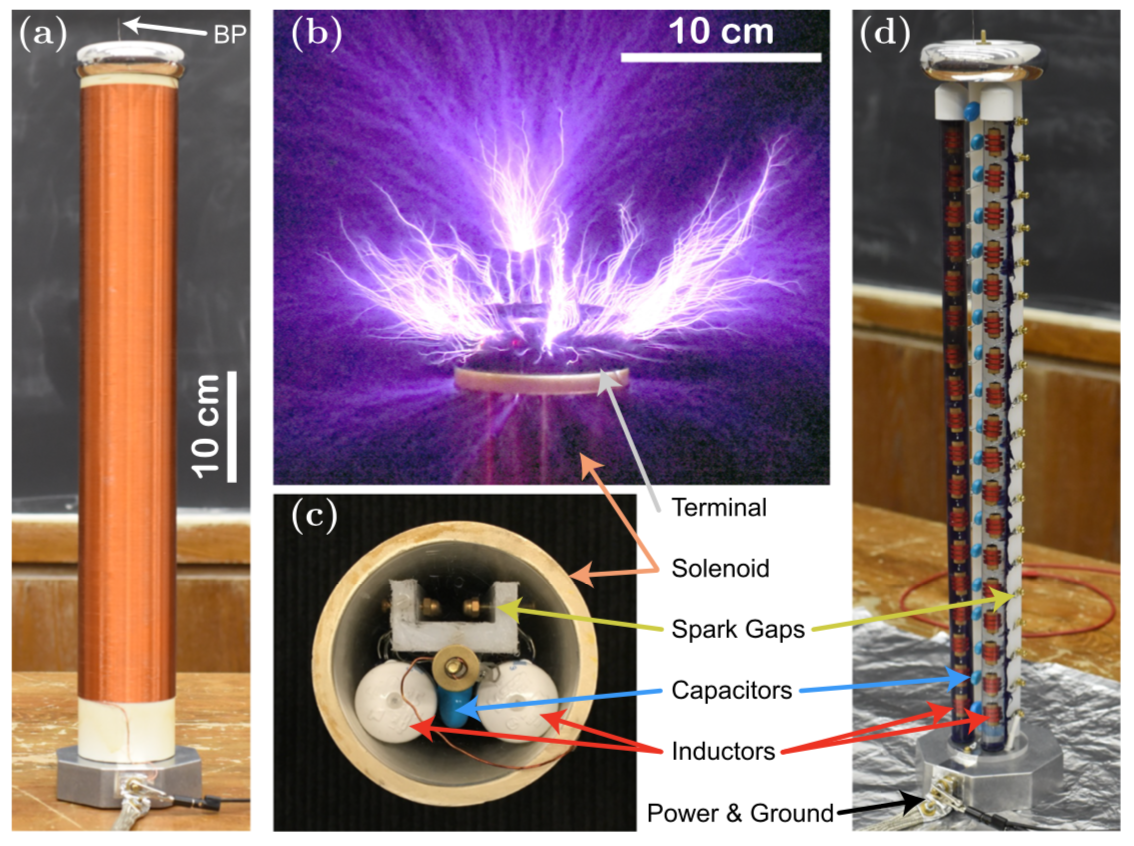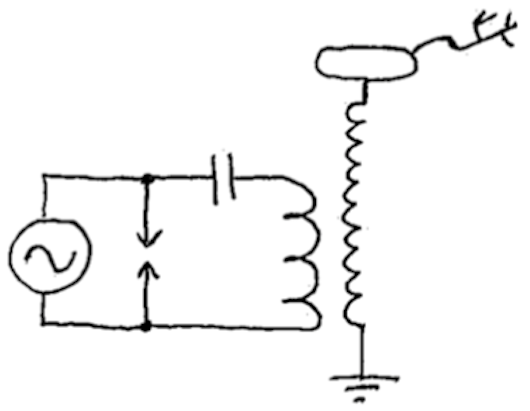Bart H. McGuyer
Can a Marx generator produce sparks like a Tesla coil?
TLDR: Yes! If a Marx generator outputs a waveform resembling that of a Tesla coil it can produce similar free, dancing sparks [1].
Tesla coils remain popular for classroom demonstrations and DIY/Maker projects. I suspect the main reason for this is that they readily produce sparks that are much more fascinating to watch than sparks from similar high voltage devices. Instead of mild purple wisps or brief loud flashes between electrodes, they can produce large, visually persistent and evolving spark structures that freely branch off a single terminal in air.
It’s interesting to wonder if other devices could be modified to produce sparks similar to Tesla coils. Specifically, if they could produce sparks that appear to dance off a single terminal. Tesla coils typically achieve this illusion by repeatedly outputting burst of radio frequency (RF) high voltage, each of which can reestablish and elongate the spark pathways from previous bursts. What would happen if a different device was made to work similarly?
I became curious about this because I was interested in a problem called “streamer loading:” Tesla coil enthusiasts suspect that one of the limits to producing long sparks comes from how sparks change the coupling between resonant circuits in a Tesla coil [1]. Wondering how to get around this, a direct approach seemed to be eliminating the need for resonant coupling. That is, throwing away one of the resonant circuits. In that case, what’s left is no longer a Tesla coil [2], so where to begin?
I decided to try and modify a Marx generator to produce output like a Tesla coil [1]. Marx generators are also popular DIY/Maker projects, but they normally produce a single, intense quasi-DC spark between two terminals. I built a small one that instead produced bursts of RF repeatedly like a Tesla coil. Importantly, I fit it inside a solenoid resembling a Tesla coil’s secondary, which minimized a lot of unwanted circuit and corona losses. The first time I tried the generator inside a solenoid, it produces sparks just like those from a Tesla coil! Here’s a video of it in action from [1]. And, if you're curious, yes, it should help with streamer loading – you can read more about that in [1].

Figure 1, adapted from [1]: "Marx coil." (a) Side view showing a metal terminal above a single-layer solenoid inductor and a metal base with power and ground wiring. BP = breakout point. (b) Spark discharge. (Video link.) (c) View beneath the terminal showing the Marx generator inside the solenoid. (d) Side view without the solenoid, showing the Marx generator above a ground plane.
If you’re interested in building another “Marx coil” like this, there’s some documentation available in [1]. [Obligatory warning: This device is dangerous, likely more so than a comparable Tesla coil because it lacks isolation from resonant coupling. Proceed at your own risk!] One interesting aspect is that I needed inductors that could withstand several kV of RF. My approach used cheap ferrite-core inductors submerged in mineral oil to prevent flashovers. I was surprised to see that mineral oil moves with high voltage and can even flow away from an inductor, sucking air down to it. In the end, I confined the oil in clear PVC pipes. Unfortunately, I was unable to remove all the air at the top of the pipes. Exposure to high fields burned the oil near those interfaces over time, creating black particles that rained down. Sadly, this caused a cascade of inductor failures, eventually ruining most of them.


Figure 2: Comparison of simplified Tesla coil (left) and "Marx coil" (right) circuits. The Marx coil resembles a Tesla coil with the primary circuit elements (spark gap, capacitor, and inductor) divided into several parts and interlaced. However, there's no resonant coupling in the Marx coil, making it rather insensitive to changes to its circuit parameters [1].
If you've built something similar, please let me know: moc (tod) reyugcmtrab (ta) em-tcatnoc. I’m optimistic that there’s a lot of room left for exploration.
References- [1] B. H. McGuyer, "Note: Investigation of a Marx Generator Imitating a Tesla Transformer,"
Rev. Sci. Instrum. 89, 086102 (2018).
( PDF, Supplemental Material, Video ) - [2] Well, modern Tesla coil designs have really blurred the definition of what exactly is a Tesla coil, so maybe this still counts?
(October 2019)
© , bartmcguyer.com